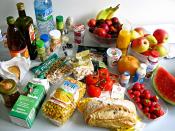(Q1) Company and Industry Overview
Whole Food Markets is America's biggest chain of natural and organic food supermarkets. The products it sells are free of additives, colorings, preservatives, pesticides, hormones, antibiotics and any genetically modified ingredients. In 2005, the group has 159 stores in United States, 7 stores in United Kingdom and 2 stores in Canada. The company will continue to pursue opportunities in Canada and eventual expansion throughout Europe.
The global organic food industry has been growing at over 20% per annum along with an increase in accessibility . The world market was calculated to be worth over $14.4B in 1999. The largest markets of organic food exists in the USA, with sales of $6.5B, Germany $2.4B and Japan $1.4B. Buyers of organic food are affluent, better educated, in the age bracket of 18-34 or 45-54. They live in small households and have low confidence in food safety regulation.
Products range from baby food, meat, dairy, non-dairy beverages, bakery, produce to Ready to Go Meals.
In United States, the retail sales of natural products grew to over $18.3B in 2003, an 8% growth compared to prior year compared to a relatively flat growth in the traditional grocery industry. This growth reflects a broadening of the natural products consumer base. While the USA organic market is still growing in absolute terms, the market is predicted to drop slightly as the industry matures and consolidates over the next 5 years.
Europe accounted for 45-50% of global organic food sales . Food fears such as Mad Cow disease, industry-related promotions and government subsidy programs have been the main driver of the industry in Europe. For most of the last decade, Europe had the largest market however it has been overtaken by North America. Market growth slowed to 7% in 2002. The German...


